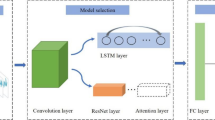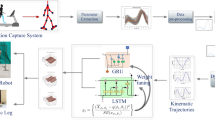Abstract
Accurate prediction of human locomotion intent benefits the seamless switching of lower limb exoskeleton controllers in different terrains to assist humans in walking safely. In this paper, a deep belief network (DBN) was developed to construct a multimodal framework for recognizing various locomotion modes and predicting transition tasks. Three fusion strategies (data level, feature level, and decision level) were explored, and optimal network performance was obtained. This method could be tested on public datasets. For the continuous performance of steady state, the best prediction accuracy achieved was 97.64% in user-dependent testing and 96.80% in user-independent testing. During the transition state, the system accurately predicted all transitions (user-dependent: 96.37%, user-independent: 95.01%). The multimodal framework based on DBN can accurately predict the human locomotion intent. The experimental results demonstrate the potential of the proposed model in the volition control of the lower limb exoskeleton.







Similar content being viewed by others
References
Sun W, Lin JW, Su SF, Wang N, Er MJ. Reduced adaptive fuzzy decoupling control for lower limb exoskeleton. IEEE Transact Cybernetics. 2021;51(3):1099–109.
Li Z, Zhao K, Zhang L, Wu X, Su CY. Human-in-the-loop control of a wearable lower limb exoskeleton for stable dynamic walking. IEEE/ASME Trans Mechatron. 2021;26(5):2700–11.
Ma Y, Wu XY, Yang SX, Dang C. Online gait planning of lower-limb exoskeleton robot for paraplegic rehabilitation considering weight transfer process. IEEE Trans Autom Sci Eng. 2021;18(2):414–25.
Anderson AJ, Hudak YF, Muir BC, Aubin PM. Design, control, and evaluation of a robotic ankle-foot prosthesis emulator. IEEE Transact Med Robot Bionics. 2023;5(3):741–52.
Zheng E, Wang Q, Qiao H. Locomotion mode recognition with robotic transtibial prosthesis in inter-session and inter-day applications. IEEE Transact Neural Syst Rehabilitation Eng. 2019;27(9):1836–45.
Li XL, Hao YF, Zhang JH, Wang C, Li D, Zhang JJ. Design, modeling and experiments of a variable stiffness soft robotic glove for stroke patients with clenched fist deformity. IEEE Robot Autom Lett. 2023;8(7):4044–51.
Gao Y, Jia B, Houston M, Zhang Y. Hybrid EEG-fNIRS brain computer interface based on common spatial pattern by using EEG-informed general linear model. IEEE Trans Instrum Meas. 2023;72:1–10.
Huang C, **ao Y, Xu G. Predicting human intention-behavior through EEG signal analysis using multi-scale CNN. IEEE/ACM Trans Comput Biol Bioinf. 2021;18(5):1722–9.
Elsayed NE, Tolba AS, Rashad MZ, Belal T, Sarhan S. A deep learning approach for brain computer interaction-motor execution EEG signal classification. IEEE Access. 2021;9:101513–29.
Park S, Lee D, Chung WK, Kim K. Hierarchical motion segmentation through sEMG for continuous lower limb motions. IEEE Robot Autom Lett. 2019;4(4):4402–9.
Ryu J, Kim DH. Real-time gait subphase detection using an EMG signal graph matching (ESGM) algorithm based on EMG signals. Expert Syst Appl. 2017;85:357–65.
Gautam A, Panwar M, Biswas D, Acharyya A. MyoNet: a transfer-learning-based LRCN for lower limb movement recognition and knee joint angle prediction for remote monitoring of rehabilitation progress from sEMG. IEEE J Transl Eng Health Med. 2020;8:1–10.
Shi X, Qin P, Zhu J, Zhai M, Shi W. Feature extraction and classification of lower limb motion based on sEMG signals. IEEE Access. 2020;8:132882–92.
Kang I, Molinaro DD, Choi G, Camargo J, Young AJ. Subject-independent continuous locomotion mode classification for robotic hip exoskeleton applications. IEEE Trans Biomed Eng. 2022;69(10):3234–42.
Su BY, Wang J, Liu SQ, Sheng M, **ang K. An improved motion intent recognition method for intelligent lower limb prosthesis driven by inertial motion capture data. Acta Autom Sin. 2018;46(7):1517–30.
Su BY, Wang J, Liu SQ. A CNN-based method for intent recognition using inertial measurement units and intelligent lower limb prosthesis. IEEE Trans Neural Syst Rehabil Eng. 2019;27(5):1032–42.
Narayan A, Reyes FA, Ren M, Haoyong Y. Real-time hierarchical classification of time series data for locomotion mode detection. IEEE J Biomed Health Inform. 2022;26(4):1749–60.
Papapicco V, Chen B. A classification approach based on directed acyclic graph to predict locomotion activities with one inertial sensor on the thigh. IEEE Transact Med Robot Bionics. 2021;3(2):436–45.
Attal F, Amirat Y, Chibani A, Mohammed S. Automatic recognition of gait phases using a multiple-regression hidden markov model. IEEE/ASME Trans Mechatron. 2018;23(4):1597–607.
Huang L, Zheng J, Hu H. A gait phase detection method in complex environment based on DTW-mean templates. IEEE Senors J. 2021;21(13):15114–23.
Hu H, Zheng JB, Zhan E, Yu L. Curve similarity model for real-time gait phase detection based on ground contact forces. Sensors. 2019;19:3235.
Cui C, Bian G, Hou Z, Zhao J. A multimodal framework based on integration of cortical and muscular activities for decoding human intentions about lower limb motions. IEEE Trans Biomed Circuits Syst. 2017;11(4):889–99.
Tucker MR. Control strategies for active lower extremity prosthetics and orthotics: a review. J Neuroeng Rehabil. 2015;12(1):1–29.
Godiyal AK, Mondal M, Joshi SD. Force myography based novel strategy for locomotion classification. IEEE Transact Human-Machine Syst. 2018;48(6):648–57.
Al-Quraishi MS, Elamvazuthi I, Tang TB. Multimodal fusion approach based on EEG and EMG signals for lower limb movement recognition. IEEE Senors Journal. 2021;21(24):27640–50.
Wang Y, Cheng X, Jabban L, Sui X. Motion intention prediction and joint trajectories generation toward lower limb prostheses using EMG and IMU signals. IEEE Senors J. 2022;22(11):10719–29.
Camargo J, Flanagan W, Csomay-Shanklin N, Kanwar B, Young A. A machine learning strategy for locomotion classification and parameter estimation using fusion of wearable sensors. IEEE Trans Biomed Eng. 2021;68(5):1569–78.
Cui C, Bian GB, Hou ZG, Zhao J, Su GD, Zhou H, Peng L, Wang WQ. Simultaneous recognition and assessment of post-stroke hemiparetic gait by fusing kinematic, kinetic, and electrophysiological data. IEEE Transact Neural Syst Rehabil Eng. 2018;26(4):856–64.
Zhao Y, Wang J, Zhang Y, Liu H. Flexible and wearable EMG and PSD sensors enabled locomotion mode recognition for IoHT-based in-home rehabilitation. IEEE Senors J. 2021;21(23):26311–9.
Sun Y, Lo B. An artificial neural network framework for gait-based biometrics. IEEE J Biomed Health Inform. 2019;23(3):987–98.
Zhang K, Wang J, De Silva CW, Fu CL. Unsupervised cross-subject adaptation for predicting human locomotion intent. IEEE Transact Neural Syst Rehabil Eng. 2020;28(3):646–57.
Lee UH, Bi J, Patel R, Fouhey D. Image Transformation and cnns: a strategy for encoding human locomotor intent for autonomous wearable robots. IEEE Robot Automation Lett. 2020;5(4):5440–7.
Moon J, Jung J, Kang E, Choi SI. Open set user identification using gait pattern analysis based on ensemble deep neural network. IEEE Senors J. 2022;22(17):16975–84.
Hu B, Rouse E. Benchmark datasets for bilateral lower-limb neuromechanical signals from wearable sensors during unassisted locomotion in able-bodied individuals. Front Robot AI. 2018;5(14):1–5.
Pan T, Tsai WL, Chang CY, Yeh CW. A hierarchical hand gesture recognition framework for sports referee training-based EMG and accelerometer sensors. IEEE Transact Cybern. 2022;52(5):3172–83.
He H, Fan Z, Levi JH, Zhi D, Daniel RR, Kevin BE. Continuous Locomotion-Mode Identification for Prosthetic Legs Based on Neuromuscular-Mechanical Fusion. IEEE Transact Biomed Eng. 2011;58(10):2867–75.
Funding
This work was supported by [Tian** Outstanding Youth Fund Project, Natural Science Foundation of Hebei Province, National Natural Science Foundation of China and National Key R&D Program of China] (Grant numbers [19JCJQJC61600], [F2020202051], [F2020202053], [62203149] and [2022YFC3601704]).
Author information
Authors and Affiliations
Contributions
All authors contributed to the study conception and design. Material preparation, and analysis were performed by [JL], [JZ], [KL], [JC] and [HL]. The first draft of the manuscript was written by [JL] and all authors commented on previous versions of the manuscript. All authors read and approved the final manuscript.
Corresponding author
Ethics declarations
Conflict of interest
The authors have no relevant financial or non-financial interests to disclose.
Ethical approval
This experiment was based on a public dataset and did not require ethics approval.
Consent to participate
Not applicable.
Consent to publications
All authors are consent for publication.
Additional information
Publisher's Note
Springer Nature remains neutral with regard to jurisdictional claims in published maps and institutional affiliations.
Rights and permissions
Springer Nature or its licensor (e.g. a society or other partner) holds exclusive rights to this article under a publishing agreement with the author(s) or other rightsholder(s); author self-archiving of the accepted manuscript version of this article is solely governed by the terms of such publishing agreement and applicable law.
About this article
Cite this article
Li, J., Zhang, J., Li, K. et al. A multimodal framework based on deep belief network for human locomotion intent prediction. Biomed. Eng. Lett. 14, 559–569 (2024). https://doi.org/10.1007/s13534-024-00351-w
Received:
Revised:
Accepted:
Published:
Issue Date:
DOI: https://doi.org/10.1007/s13534-024-00351-w




